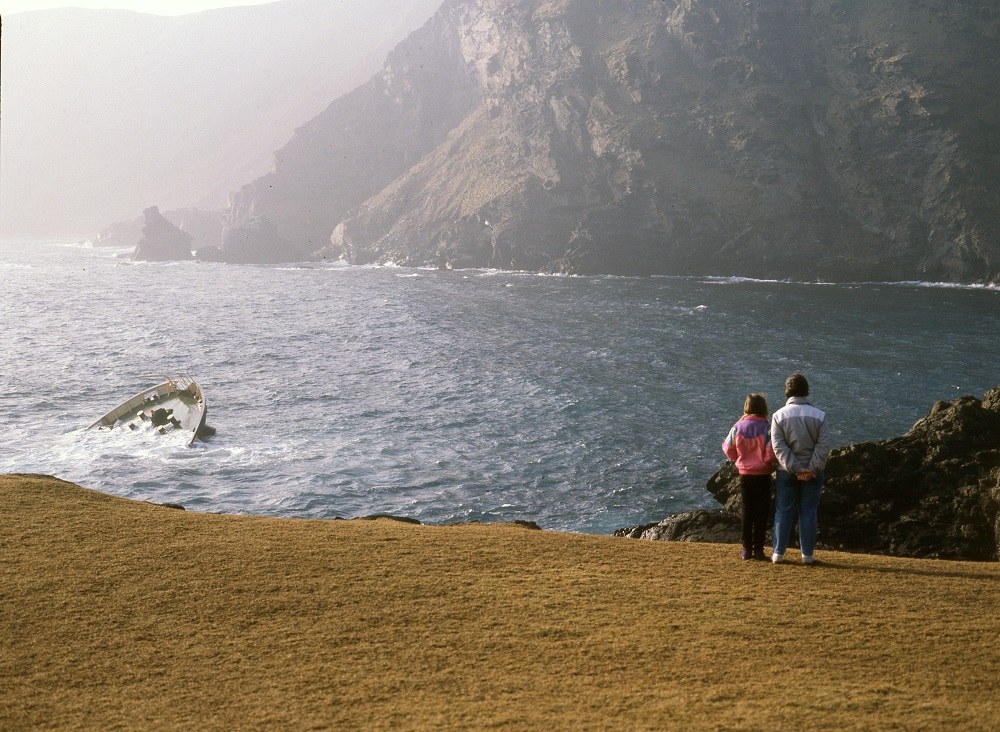On this Day in History - the Braer Oil Spill
Published: 05 January, 2023
January in Shetland is usually dark, wet, and stormy, enlivened by a few celebrations of Old Christmas and New Year. The excitement builds in Lerwick for Up Helly Aa on the last Tuesday of the month when the fire festival appears to burn off the darkness. January 1993 added extra drama, with 25 days of gale force out of 31, with the 17th showing a gust of 91 knots (104 miles per hour). Among all this something happened.
Tuesday the fifth was another stormy day, with the wind at Sumburgh Airport ranging up to a gust of 89 mph at 21.50. The airport was at the start of a very busy phase that day, as the oil tanker Braer grounded nearby at Garth’s Ness, Dunrossness, and 85,000 tons of light crude oil began to leak out. Fortunately all the crew were rescued.
Oil spillages had long been feared in Shetland. The Sullom Voe Terminal, at the other end of the island from the Ness, had begun 1979 with nasty spill of bunker oil. The big one had finally happened, with a twist – the high winds blew the light oil onshore, enough to be possibly toxic to people and livestock. In an era where mobile phones were rare and expensive people checked radio broadcasts, with Radio Shetland being invaluable, TV news, and anybody who seemed likely to know something. There was fear.
The South Mainland reeked of light hydrocarbons, a smell like an old oil heater burning ineffectively. Radio Shetland’s broadcast on the sixth had Wilbert Burgess, a farmer at Spiggie, saying you could feel it on your face. In the same broadcast Martin Hall, the Shetland Islands Council Environmental Health head said that there was no need to evacuate people. That was good to know, but the oil had reached up to Maywick on the west side. The Shetland Times came out on Friday, with a big advertisement from a law firm specialising in compensation claims.
The SIC and other agencies assembled their emergency response teams. The Marine Pollution Control Unit brought up their aircraft, the venerable Douglas Dakotas, able to fly low and slow, spraying dispersant. Mostly they weren’t used, the weather conditions were too bad. Many people were sceptical about the dispersants doing any good. The media responded, and for a brief time there was an awful lot of it. Faces normally seen on screens suddenly appeared in reality. The Duke of Edinburgh and Prince Charles visited, so did MPs and cabinet ministers.
Suddenly Shetland became a very well-known place quite abruptly, at the beginning of so many news bulletins. People began to believe the entire islands were deeply polluted. By the eleventh, the Shetland fishing industry was inviting the journalists to the Lerwick fishmarket to see for themselves. John Goodlad, Shetland Fishermens Association secretary said that the fish catch will be as it's aye been, of the highest quality standard. The salmon farming, and tourism industries had to make marketing efforts too.
Radio Shetland reported the tanker breaking up on the eleventh of January, along with an estimate of 625 dead oiled birds. What was going to happen? On the fourteenth, they reported the emergency officially over, the media pack leaving. A long phase of monitoring, compensation claims, and litigation and so on followed. International oil transportation is a complex industry to say the least.
There had been so much energy in the ocean over the last few days of the Braer that the oil had been thoroughly mixed in a large area of seawater. It was light oil crude too, not a tarry substance, and that helped. For a short time there was a strange feeling that we were seeing the normal Shetland, not the blighted one we’d expected. There was little that could be done, really. The weather meant the limited number of counter-measures available couldn’t be deployed, and salvage was impossible. We might say the islands dodged the bullet, but it was more like the bullet’s course passed beyond us, onto wherever it was going to land next.
By Angus Johnson, assistant archivist at Shetland Museum and Archives.


